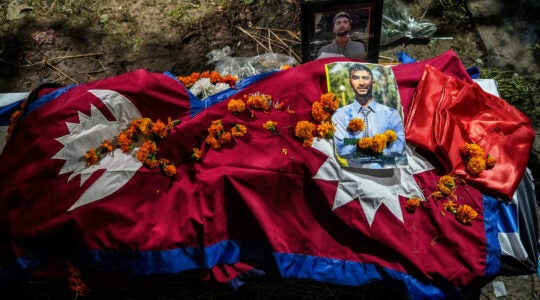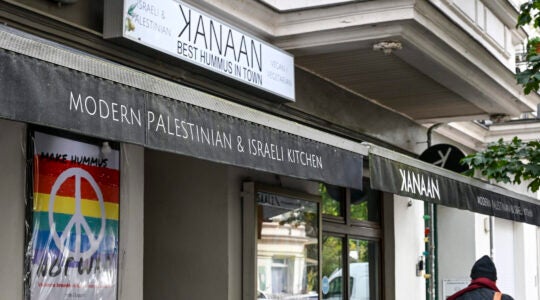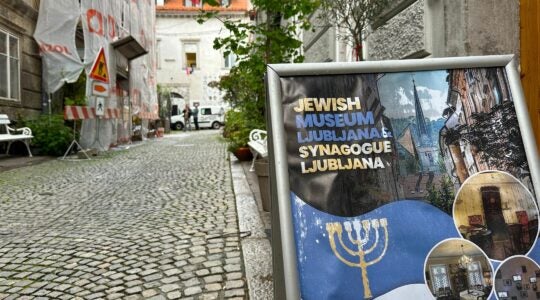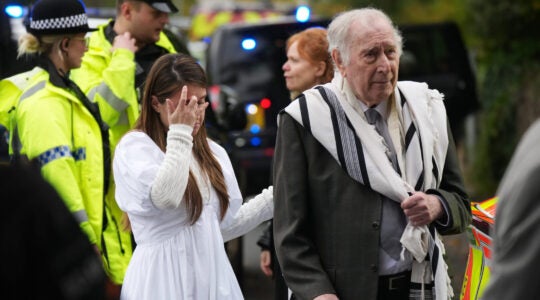BERLIN (JTA) — Teachers and family gave Erik Thews some strange looks and comments when he began his school project about anti-Semitism in the former East Germany.
His work, and that of many other German students, is on display now in a traveling exhibit called "There was no such thing! — Anti-Semitism in the German Democratic Republic."
This week it opens in a new venue in time for ceremonies marking the 70th anniversary of Kristallnacht, the pan-Germanic pogrom against Jews and their property on Nov. 9, 1938.
Given the German tendency toward self-critical analysis, it is not surprising that programs are planned throughout the country marking the major anniversary of a mass riot that in hindsight was a revealing precursor to the Holocaust.
Kristallnacht is marked annually, but this year with particular intensity. The German government and the Central Council of Jews in Germany are jointly sponsoring a ceremony at the Rykestrasse Synagogue in the former east Berlin, one of the few synagogues to survive the war intact.
Berlin’s Jewish community will mark the day at the community center on Fasanenstrasse, the former site of a synagogue destroyed in the pogrom. Among the dozens of other ceremonies in Germany, some are sponsored by civic and religious organizations.
Survivors and eyewitnesses are returning to talk with a generation for whom this is all distant history. And Israeli investigative journalist Yoran Svoray announced recently that he had discovered Kristallnacht detritus in an old dump outside Berlin.
The theme has brought controversy in the German parliament, where legislators had hoped to pass a resolution on combating anti-Semitism in time for Nov. 9.
A carefully crafted, nonpartisan statement fell apart when conservative legislators insisted on mentioning anti-Semitism in the former East Germany, and the Left Party suggested the conservatives look within their own ranks.
"To be very frank, it is sad to observe that in the very last moment there is this kind of trouble occurring," project initiator Gerd Weisskirchen of the Social Democratic Party told JTA in a telephone interview. "We had been working on this issue since last March" in anticipation of the anniversary, he said, adding that "there is still hope that we could overcome this turbulence" in time for the commemorative ceremonies.
Meanwhile, the traveling exhibit on East German anti-Semitism, booked through 2010, illustrates Germans looking within. This week it opens in Pasewalk, a town in the former East Germany.
By no means does the display suggest that postwar anti-Semitism was only a problem in the former East Germany, but it does suggest that the phenomenon there remains less explored.
"There was no such thing!" is a project of the Berlin-based Amadeu Antonio Foundation under director Anetta Kahane, a Berlin Jew who grew up in the former East Germany.
The exhibit, in German, covers several aspects of anti-Semitism in the communist state. They include the culture of Holocaust remembrance and negative attitudes toward reparations; rejection of Israel; vandalism of Jewish cemeteries; right-wing extremism in the transitional period to German unification; and the Middle East conflict.
Kristallnacht is a sub-theme. In the last days of the German Democratic Republic, or GDR, the communist state’s leaders made a major effort to commemorate the 50th anniversary of the pogrom — but were their efforts sincere?
Researching archives and documents with student volunteers, "We found that the GDR was looking for most-favored-nation trade status” and thus tried to impress the United States with its concern for Jews and Israel, said foundation staff member Heike Radvan, who worked on the exhibit.
East Germany "was in such bad economic shape, and so they were looking for international support. Certain anti-Semitic stereotypes were still in the minds of the leaders. They thought the support of Washington could be reached through Jerusalem, so to speak."
So "all of a sudden it was possible to finish certain projects that Jewish communities [in East Germany] had been trying to realize for years" — like the renovation of the synagogue at Oranienburgerstrasse in Berlin, and a big public ceremony marking Kristallnacht.
Such apparent philosemitism was really just another face of anti-Semitism, says author Salomea Genin, who has written about her experiences as a Jew in former East Germany.
"The problem of anti-Semitism in East Germany was very subtle and never expressed directly," Genin said, but "to say anti-Semitism didn’t happen here" is "nonsensical, absolutely nonsensical."
Genin, who was born in Berlin in 1932, fled with her family to Australia but later moved to East Germany out of political convictions. It was a decision she would regret.
"Most people in the GDR were convinced that all Jews were rich," said Genin, who read from her autobiography at a recent opening of the exhibit. "They did not even know it was an anti-Semitic stereotype because it wasn’t discussed. They thought that to be an anti-Semite you had to be a murderer."
It was East Germany’s support for terrorist groups such as Abu Nidal that particularly interested Thews, 21, who since has graduated from the John Lennon Gymnasium in Berlin and wants to be an actor. With help from foundation intern Konstanze Ameer, he and other students were able to review documents from East German archives.
Ameer, now a paid consultant for the foundation, "brought us a thick pile of documents" from the formerly secret archives, Thews said.
One document, reproduced in the exhibit, lists forms of political and military assistance to Abu Nidal — under a code name — including instructions on how to use rocket launchers.
According to the Soviet-steered East German doctrine, Palestinians were defined as "freedom fighters, so you had to support them," Thews said. "But Abu Nidal [which found the PLO too mild] was a pure murder group. And I find it quite crass that they got government support."
Ameer told JTA that some students had a hard time grasping what this had to do with anti-Semitism, but at least they were trying. Some Germans, Ameer said, couldn’t and did not want to understand.
"When we opened the exhibition for the first time, there was a woman who broke into tears," but not out of sympathy, Ameer said. The woman shouted that she had always cleaned swastika graffiti off walls and she had raised six children in East Germany.
"How dare you now talk about my life, my children and my work and passion in this way?" she yelled.
One student told Ameer her parents were unhappy about the research project. They told the student that East Germany never supported terrorists.
The student challenged her parents, saying, "You told me the GDR was a state that lied and lied and lied. So what is the point? Now you tell me that the adviser at the foundation is a liar."
Thews’ parents were more supportive. But his grandfather "asked me what kind of s*** am I up to," Thews said.
"The coordinator of my school-leaving exam laughed at me. He said there was never anything like that."
###
JTA has documented Jewish history in real-time for over a century. Keep our journalism strong by joining us in supporting independent, award-winning reporting.





